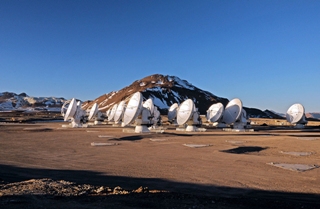Aug 20 2014
European astronomy journalists can win a trip to the ESO telescope facilities in Chile with the launch of the European Astronomy Journalism Prize 2014.
 Nineteen ALMA antennas on the Chajnantor plateau. (Credit: ALMA (ESO/NAOJ/NRAO)/W. Garnier (ALMA))
Nineteen ALMA antennas on the Chajnantor plateau. (Credit: ALMA (ESO/NAOJ/NRAO)/W. Garnier (ALMA))
This marks the third successive year for this popular award for journalists, as well as students of journalism and astronomy. Run by the Science and Technology Facilities Council (STFC) and the European Southern Observatory (ESO), in conjunction with the Association of British Science Writers and the Royal Astronomical Society, the aim of the competition is to celebrate the outstanding coverage of astronomy and in particular work that enthuses the audience of the importance of astronomy.
STFC Head of Communications Terry O’Connor said: “We’re delighted to work with ESO once again, and to offer the winner a trip to the largest astronomical project in existence, the Atacama Large Millimeter/submillimeter Array (ALMA) in Chile. This is a rare and fantastic opportunity for anyone who is fascinated by astronomy. Last year’s entries were a privilege to read and judge as the standards were so outstandingly high. I was thrilled to see how much enthusiasm and quality coverage had been achieved last year, so I am really looking forward to seeing this year’s entries.”
ALMA is located 5000 metres above sea level in the Atacama Desert, on the high-altitude Chajnantor Plain, in Northern Chile. Comprising fifty 12 metre antennae plus a compact array of sixteen antennae it will allow astronomers to observe and image with unprecedented clarity the enigmatic cold regions of the universe.
Entries for the Prize must be about astronomy and related areas of technology, or about the work and lifestyles of astronomers, engineers or others working in the field of astronomy.
The entries must reflect European interests and they can be online, written or broadcast.
Entries must have been published or broadcast during the period 1 August 2014 to 28 November 2014 inclusive. Applications close on Friday 28 November 2014.
Entry is open to journalists, students of a recognised journalism course, students of a recognised qualification in astronomy, or holders of a recognised qualification in astronomy, whose work is published or broadcast and is accessible to the general public. You may be asked to provide proof of your status.